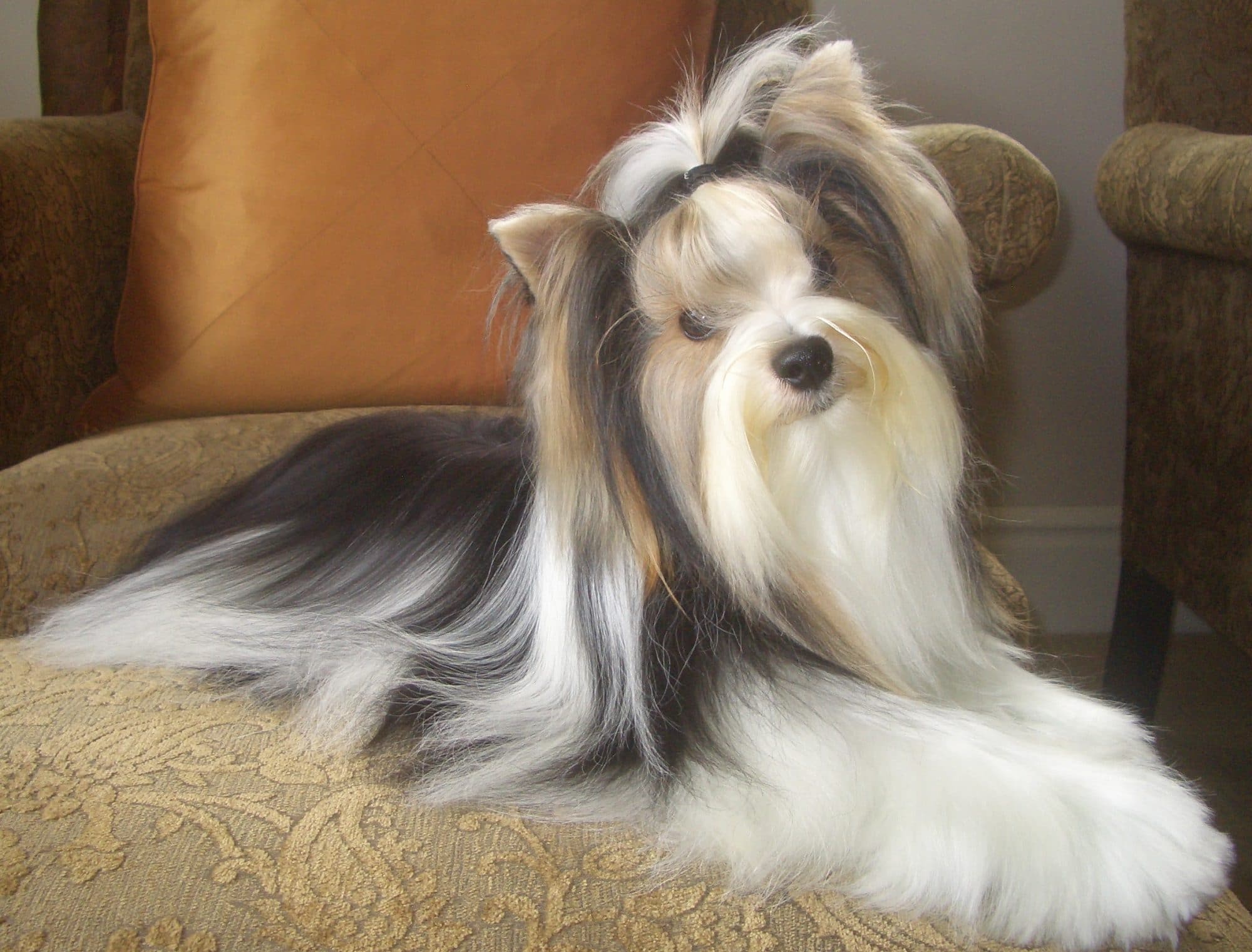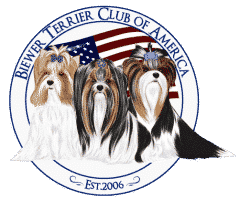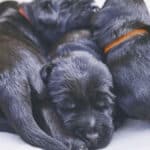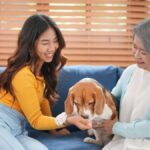How to Judge the Biewer Terrier | It is with great excitement that the Biewer Terrier joined the AKC fully-recognized breeds on January 01, 2021. It is incredible that this beautiful little dog, which was relatively unknown just a few years back, is now featured in movies, television, magazines, and product ads.
Fortunately for the breed, the parent club, Biewer Terrier Club of America, has developed a very thorough and comprehensive Judges Education Program. With perseverance, we hope to get the breed off to a good start in the show ring and, hopefully, avoid any future conflicts on how to judge and show our breed.
Biewer Terrier Standard
How to Judge the Biewer Terrier | General Appearance
The Biewer Terrier is an elegant, longhaired, uniquely colored toy terrier with a breed signature ponytail. The coat parts down the middle, hanging straight and evenly on both sides of the body as though a comb has been used to part it. The back is level, with height at the withers being equal to height at the croup. Although the outline of the dog gives the appearance of a square, the body length is slightly longer than the overall height. The tail is set high and carried well arched over the body, covered with a long luxurious plume. The Biewer Terrier has a lighthearted whimsical, childlike attitude. Although mischievous at times, they are obedient and make a loyal companion.
How to Judge the Biewer Terrier | Size, Proportion, Substance
Height—at the withers is the same as the height at the croup, measuring 7 to 11 inches. Weight—is between 4 to 8 lbs. Proportion—Length of body from prosternum to ischium is longer than over all height, making the dog off square although square is acceptable. Substance—The body is fine to medium boned with a level topline.
Serious Fault—Over 8 lbs.
How to Judge the Biewer Terrier | The Head
Expression—Is more human than that of a dog, being bright and intelligent. Eyes—Are medium-sized and may be round or almond-shaped with a crisp, clear countenance. Iris—as dark as possible. Ears—Are small, upright, V-shaped, moderately wide-set and covered with hair except the tips being shaved. They are set to the back of the skull and the base is level with the eyes. Skull—Slightly rounded. Stop—Moderate. Muzzle—One-third the length of the head. Eye rims, Nose, and Lips—Completely black. Bite—Level or scissor bite. Teeth—Straight and even.
Serious Fault(s)—Incomplete
pigment on the eye rims, nose, and lip; Ears not standing erect.
Disqualification—Blue eye(s); Brown or liver pigmentation of the eye rims, nose, and lips.
How to Judge the Biewer Terrier | Neck, Topline and Body
Neck—Moderate in length, free from throatiness. Topline—Level. Body—length is slightly longer than the overall height, although square is acceptable. Chest—Comes to the elbows with a good width. Ribs—Moderately sprung. Underline—Slightly tucked up. Back—Level topline. Loin—Well developed and strong. Tail—Set high, when in movement carried well arched over the body in a graceful sickle curve, covered with a long luxurious plume. The plume lies to either side of the body. The length of tailbone must go to the stifles or longer. When reposed, the tail may be relaxed. A kink in the tail is not to be faulted.
Serious Fault(s)—Roach or rounded back; high in the front or rear.
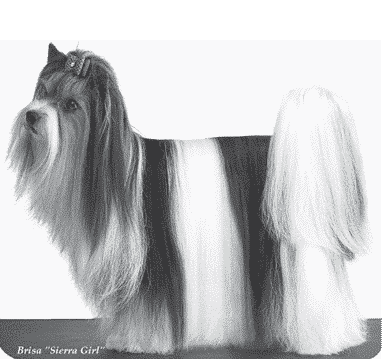
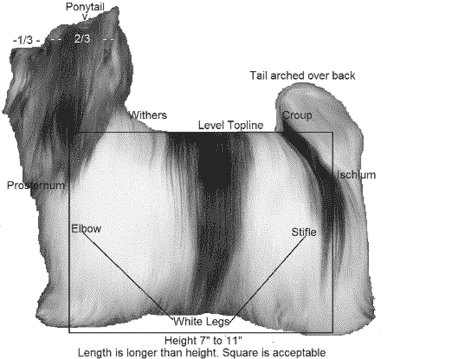
How to Judge the Biewer Terrier | Forequarters
Forelegs—Should be straight, elbows neither in nor out. Angulation—Moderate. Shoulders—Nicely laid back to allow for good reach and freedom of movement. Elbows—Set close to the body. Legs—Straight when viewed from the front are muscular and covered with hair. Pasterns—Up and straight. Dewclaws—May be removed, but not required. Feet—Round. Toes—Well arched, covered with hair which may be trimmed not to impede movement or trimmed to show the shape of the foot. Pads—Black and/or flesh. Nails—Black and/or white.
Disqualification—Brown or liver pigmentation of the pads.
How to Judge the Biewer Terrier | Hindquarters
In balance with the forequarters. Angulation—Rear to match front. Legs—Hind legs are straight when viewed from behind, muscular and covered with hair. Stifle—Slightly bent when viewed from the side. Hocks—Straight when viewed from behind, pointing neither in nor out. Dewclaws—May be removed, but not required. Feet—Round. Toes—Well arched, covered with hair which may be trimmed not to impede movement or trimmed to show the shape of the foot. Pads—Black and/or flesh. Nails—Black and/or white.
Disqualification—Brown or liver pigmentation of the pads.
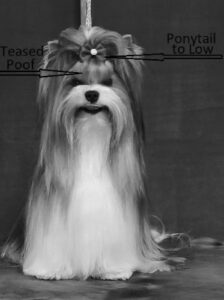
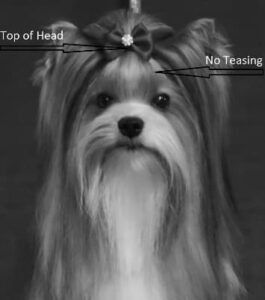
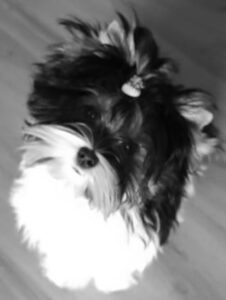
How to Judge the Biewer Terrier | Coat
Long and flowing with a soft, silky texture. Hair is straight without an undercoat, hanging close to the ground if not touching. The coat maybe trimmed to floor length for ease of movement. Head fall is tied up into a single ponytail on top of the head, hanging loose. Puppy ponytails may be placed a little lower on the head as to gather the short hairs. A bow is used for adornment; no topknots or rollovers. Feet are trimmed for a neat, clean appearance. Trim around anus. Head falls that display topknots or roll overs common to other breeds shall be so severely penalized as to be eliminated from competition.
(Authors’ Note: The hair cannot be teased to make a big poof on the forehead when making a ponytail. The ponytail must be on top of the head, not in the middle of the forehead. A puppy may have the pony tail a little lower on the head to gather the hairs. This ponytail is long enough so that it should be on top of the head, not down on the forehead. If dogs enter the show ring with these faults, they are not to be put up. Our dogs are not Yorkies and we do not want them groomed like one.)
How to Judge the Biewer Terrier | Color
The Biewer Terrier is a uniquely colored toy Terrier. Head Coloring—Blue/Black, Gold/Tan and White in good symmetry. Any combination of the following two colors: Blue/Black and Gold/Tan OR Gold/Tan and White in good symmetry is acceptable. Body Coloring—Hair on the back is blue/black and white. Amounts of each color are of personal preference with no dominating patterns. No amount of tan hair may be found on the back, belly, chest, legs or feet. A small amount of tan hair may be found around the anus. Chest, Stomach, Legs and Tip of the Tail—White. The white from the chest should come up the neck to cover the chin. Legs are to be white from the elbows and stifles to the feet.
Disqualification—Any other color or combination of colors other than those that are listed.
(Authors’ Note: The accepted colors for the head are listed in the standard. Black and white is not an accepted head coloring.)
How to Judge the Biewer Terrier | Gait
The Biewer Terrier moves with confidence and pride. Movement should be graceful, smooth and straightforward, without being stilted or hackneyed. When viewed from the side the topline remains level, he gives an impression of rapid movement, size considered. Hind legs should track in line with the front legs, going neither inside nor outside. Tail must be up when in movement.
Serious Fault—Hackneyed gait
in adults.
How to Judge the Biewer Terrier | Temperament
Intelligent, loyal, and very devoted to their human family. They have a fun-loving, childlike attitude that makes them a great companion for all ages. They quickly make friends with animals of any origin.
The foregoing description is of the ideal Biewer Terrier. Any deviation from the above-described dog must be penalized to the extent of the deviation.
How to Judge the Biewer Terrier | Serious Faults
Roach or rounded back; Hackneyed gait in adults; Incomplete pigment on the eye rims, nose, and lips; ears not standing erect; over 8 lbs.
How to Judge the Biewer Terrier | Eliminating Faults
Head falls that display topknots, or roll overs common to other breeds.
How to Judge the Biewer Terrier | Disqualifications
Blue eye(s); Brown or liver pigmentation of the eye rims, nose, lips and pads; Any other color or combination of colors other than those that are listed.
Article written by: Biewer Terrier Club of America’s Judges Education Committee Co-Chairs, Myrna Torres and Gayle Pruett


